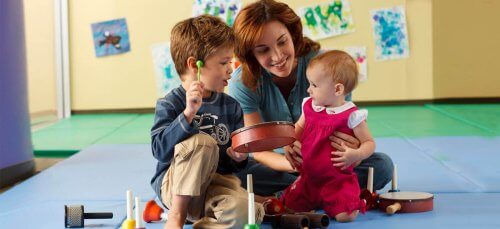3 Learning Styles in Children


Written and verified by the psychologist María Alejandra Castro Arbeláez
Thinking that all children perceive the world in the same way is similar to thinking that everyone has the same tastes. The reality is that each child receives and assimilates information through different channels and by using different learning styles.
You shouldn’t worry too much if your child doesn’t perform well in certain tasks or doesn’t enjoy a specific subject at school. This may be due to his or her unique learning style.
It’s important for parents to explore different approaches with their children to help them discover effective learning styles. After you identify methods that are right for your child, you’ll be better prepared to accompany him academically. You’ll also be able to help him reach his potential.
Psychologist David Kolb created the theory of learning styles in 1984. He believed that individual learning styles emerge due to three causal factors: genetics, life experiences and environmental demands.
3 learning styles and their characteristics
Auditory style
Children who possess this learning style are able to easily capture spoken information. Although at times it may seem like they aren’t paying attention, a child who possesses this learning style listens and understands every word.
Here are a few characteristics that children with this learning style show:
- They remember information when they say it out loud.
- They need or prefer to explain things orally.
- In some cases, it’s difficult for them to follow instructions from manuals or written texts.

- They usually speak out loud when learning something new.
- They prefer group discussions rather than independent work.
- Their emotions are easily shown through their tone and volume.
- They love to talk and also to listen.
- Their descriptions of situations are usually long and meticulous.
- They remember names easily and can be distracted by sounds.
- They love music and to sing while doing activities.
“Individual learning styles emerge due to three causal factors: genetics, life experiences and environmental demands.”
–David Kolb–
Visual style
As the name implies, these are people who learn things by seeing how they work. To enhance their cognitive processes, they need to visualize and make illustrations that allow them to conceptualize knowledge.
Some characteristics that these children portray include the following:
- They remember details that may seem insignificant about images, landscapes and faces.
- They like to be able to see things while they’re being explained to them. These children usually need to have a paper and pencil handy in order to make illustrations about their ideas.
- They prefer to follow instructions that are written down or to see demonstrations of how things are done.
- When they arrive at a new place, they analyze the environment carefully.
- They show their emotions with gestures and facial expressions.
- These children are able to describe mental images easily.
- Listening skills aren’t one of their strengths, as they usually concentrate more on things they see.
- These children remember words that they see written down. That’s why their notebooks are usually full of information.
- They plan what they’re going to do ahead of time. They usually organize their tasks by putting them in writing.
- These children are good at reading. They also usually have good handwriting.

Kinesthetic style
Children who possess this learning style enjoy being actively involved in their learning. You can enhance their learning experience by using crafts and movement.
Here are some characteristics that these children portray:
- They look for ways to apply everything they hear and see. Their favorite tool is action.
- They move their hands while talking. Touch is a very important sense for them.
- In some cases, kinesthetic learning styles are confused with hyperactivity. These children simply need to move in order to focus more.
- They show their emotions through their posture.
- They lose interest quickly when they have to remain quiet for long periods of time. Speeches or prolonged presentations tend to bore them. They need to participate directly in order to learn.
- These children remember what they did better than what they saw or heard. Experiences stay in their memories for a long period of time.
- They like to have physical contact with people to show affection. Closeness with their peers is important to them.
- Since visual association isn’t a strength that they possess, they’re usually bad at spelling.
- They enjoy interactive books that contain more than words. The more they can experiment with texts, the more they enjoy reading.
Whatever your children’s learning style may be, it’s important to find the right tools to enhance their learning experience. If you help children identify their learning style, they’ll be able to better acquire knowledge.
Thinking that all children perceive the world in the same way is similar to thinking that everyone has the same tastes. The reality is that each child receives and assimilates information through different channels and by using different learning styles.
You shouldn’t worry too much if your child doesn’t perform well in certain tasks or doesn’t enjoy a specific subject at school. This may be due to his or her unique learning style.
It’s important for parents to explore different approaches with their children to help them discover effective learning styles. After you identify methods that are right for your child, you’ll be better prepared to accompany him academically. You’ll also be able to help him reach his potential.
Psychologist David Kolb created the theory of learning styles in 1984. He believed that individual learning styles emerge due to three causal factors: genetics, life experiences and environmental demands.
3 learning styles and their characteristics
Auditory style
Children who possess this learning style are able to easily capture spoken information. Although at times it may seem like they aren’t paying attention, a child who possesses this learning style listens and understands every word.
Here are a few characteristics that children with this learning style show:
- They remember information when they say it out loud.
- They need or prefer to explain things orally.
- In some cases, it’s difficult for them to follow instructions from manuals or written texts.

- They usually speak out loud when learning something new.
- They prefer group discussions rather than independent work.
- Their emotions are easily shown through their tone and volume.
- They love to talk and also to listen.
- Their descriptions of situations are usually long and meticulous.
- They remember names easily and can be distracted by sounds.
- They love music and to sing while doing activities.
“Individual learning styles emerge due to three causal factors: genetics, life experiences and environmental demands.”
–David Kolb–
Visual style
As the name implies, these are people who learn things by seeing how they work. To enhance their cognitive processes, they need to visualize and make illustrations that allow them to conceptualize knowledge.
Some characteristics that these children portray include the following:
- They remember details that may seem insignificant about images, landscapes and faces.
- They like to be able to see things while they’re being explained to them. These children usually need to have a paper and pencil handy in order to make illustrations about their ideas.
- They prefer to follow instructions that are written down or to see demonstrations of how things are done.
- When they arrive at a new place, they analyze the environment carefully.
- They show their emotions with gestures and facial expressions.
- These children are able to describe mental images easily.
- Listening skills aren’t one of their strengths, as they usually concentrate more on things they see.
- These children remember words that they see written down. That’s why their notebooks are usually full of information.
- They plan what they’re going to do ahead of time. They usually organize their tasks by putting them in writing.
- These children are good at reading. They also usually have good handwriting.

Kinesthetic style
Children who possess this learning style enjoy being actively involved in their learning. You can enhance their learning experience by using crafts and movement.
Here are some characteristics that these children portray:
- They look for ways to apply everything they hear and see. Their favorite tool is action.
- They move their hands while talking. Touch is a very important sense for them.
- In some cases, kinesthetic learning styles are confused with hyperactivity. These children simply need to move in order to focus more.
- They show their emotions through their posture.
- They lose interest quickly when they have to remain quiet for long periods of time. Speeches or prolonged presentations tend to bore them. They need to participate directly in order to learn.
- These children remember what they did better than what they saw or heard. Experiences stay in their memories for a long period of time.
- They like to have physical contact with people to show affection. Closeness with their peers is important to them.
- Since visual association isn’t a strength that they possess, they’re usually bad at spelling.
- They enjoy interactive books that contain more than words. The more they can experiment with texts, the more they enjoy reading.
Whatever your children’s learning style may be, it’s important to find the right tools to enhance their learning experience. If you help children identify their learning style, they’ll be able to better acquire knowledge.
All cited sources were thoroughly reviewed by our team to ensure their quality, reliability, currency, and validity. The bibliography of this article was considered reliable and of academic or scientific accuracy.
- Alonso, C. M., Gallego, D. J., & Honey, P. (1999). Los estilos de aprendizage: Procedimientos de diagnóstico y mejora. In Ediciones Mensajero.
- Díaz Mosquera, E. (2017). Estilos de Aprendizaje. Eidos. https://doi.org/10.29019/eidos.v0i5.88
This text is provided for informational purposes only and does not replace consultation with a professional. If in doubt, consult your specialist.








